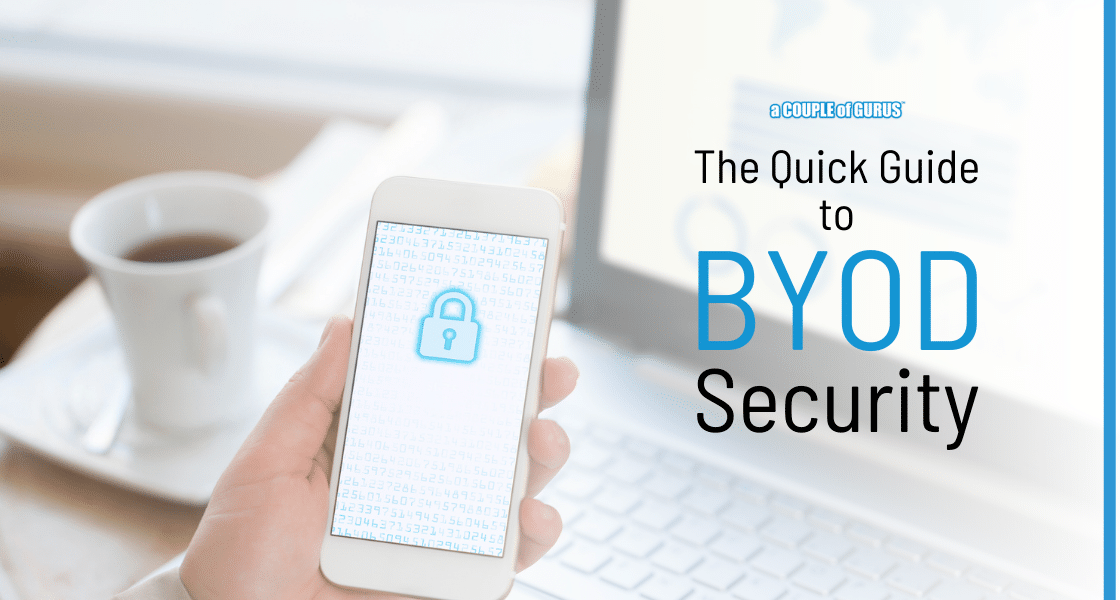The Quick Guide to BYOD Security

Bring Your Own Device (BYOD) is a trend that’s growing rapidly across a variety of industries. Learn how BYOD can benefit your business and what you need to do to mitigate the risks and challenges to make it as safe and secure as possible.
BYOD: Bring Your Own Device
Allowing employees to work on their own devices can save a company substantial amounts of money and give the employees more freedom and flexibility. With the big leap to remote work in 2020, companies have had to scramble to come up with BYOD policies, sometimes without the necessary security procedures in place.
Popularity doesn’t make it secure. BYOD can benefit businesses, but only if proper training and security protocols are implemented.
NCSAM: October is National Cybersecurity Awareness Month
October 2020 marks the 17th National Cybersecurity Awareness Month from CISA and the National Cyber Security Alliance (NCSA). The goals are to raise awareness about cybersecurity and ensure Americans have the resources needed to be safe and secure online.
This year’s theme is, “If you connect it, protect it.” Cybersecurity is a shared responsibility, one that everyone needs to be aware of. Lack of cybersecurity vigilance can impact your work, those around you, and the business overall. It’s up to everyone in an organization from the top down to prioritize security measures and take ownership of the risks any online device can pose.
BYOD provides freedom, but it also imposes increased responsibility on employees who need to manage security on their own devices, and on business owners who need to prioritize protocols and training.
Getting started: BYOD security considerations
Is BYOD safe?
BYOD is safe if proper measures and training are implemented and maintained. Companies that provide employees only with the network access they need can be at risk if they don’t also have proper cybersecurity policies in place. It’s all about being prepared and maintaining vigilant security no matter what you decide is right for your business.
Is BYOD right for your business?
Choosing BYOD depends on the needs of your business and the levels of security you maintain. Organizations that regularly deal with personal information, such as health records or government-specified CUI (Controlled Unclassified Information), may choose to reject BYOD and keep all of their devices in-house as a security precaution. Especially those needing to maintain HIPAA compliance or CMMC compliance should carefully consider how to incorporate BYOD into their workforce.
That being said, these organizations certainly can implement BYOD if they take the necessary precautions. There is a lot of money to be saved by implementing a BYOD policy, as long as the accompanying security protocols are maintained. No matter what you choose for your business, cybersecurity should be a top priority for every person that uses an online device, whether it’s their own or provided by the company.
Do you have a BYOD security policy in place?
Your business’s cybersecurity is only as strong as its weakest link. A BYOD policy can lead to a relaxed environment where employees manage their own security to varying degrees. No business should proceed with BYOD if they aren’t prepared to roll out the safety precautions it requires. It is essential to understand what devices are being used, when, and by whom in order to proceed, and have established security procedures across your organization. User vigilance then becomes your first line of cybersecurity defense, rather than its weakest link.
BYOD security risks
There are some undeniable security risks associated with BYOD, most of which are created by a lack of clear cybersecurity policies.
Some of the risks BYOD presents include:
-
- Data leaks and breaches caused by an unsecured device
- Devices containing sensitive information getting lost or stolen
- Malicious or rogue apps
- Employee non-compliance
- Company information being mistaken for an employee’s personal information and then deleted or shared
BYOD security best practices
Establish BYOD security policies
You absolutely must have security policies in place in order to safely manage BYOD. Without consistent procedures, your cybersecurity can be left to the whims and restraint of any given employee.
You need to have a detailed security plan that includes:
-
- Which devices are allowed
- What is required of employees
- What to do about lost or stolen devices
- What to do about broken devices and repairs
- How often passwords are updated
- How to transition to new devices
- How to transition new employees
- How data is backed up and recovered in an emergency
Your BYOD security policies should be clearly defined and readily available to everyone in your organization. Keep them up-to-date and ensure every new employee is familiar with them.
If you don’t have the resources or experience to establish BYOD security policies on your own, it may be time to hire a managed cybersecurity services company to bring you peace of mind.
Create transition protocols
Some of the riskiest times for businesses that allow BYOD are times of transition. When an employee leaves or is fired, they still have access to business data, files, and passwords that could get lost or stolen.
Create transitional protocols that everyone is aware of to ensure business data remains secure as employees come and go. Make sure all passwords are updated after an employee leaves to prevent theft of data and other cybersecurity risks. You can’t know what a former employee will do with their device after they leave, and a business password that’s saved on the device could get into the wrong hands if the credentials aren’t changed immediately.
Maintain up-to-date security and systems
Devices will be safer the more you stay up-to-date with security. Update browsers, operating systems, applications, and access credentials often with the most recent firmware and security patches. When it comes to cybersecurity, vigilance is the name of the game. If you have to wonder about the last time any part of your business infrastructure had a cybersecurity upgrade, you’re already past due.
Provide BYOD security training for all employees
Security training in general is hugely important, and it’s something that’s often overlooked. Specifically with BYOD, you expect your employees to understand how to use their own devices, but that doesn’t mean they have the base training needed to understand cybersecurity.
Invest in your team and your business’s security by providing mandatory training for all employees, covering both BYOD-specific and general security. Training should include best practices, password management procedures, transition protocols, and your company’s BYOD security policies.
Is your BYOD strategy safe and secure?
BYOD offers many advantages to both businesses and employees, but with that freedom comes responsibility. Talk to an expert at a COUPLE of GURUS to learn more about the benefits of BYOD and how to implement a strategy that is safe and secure.




